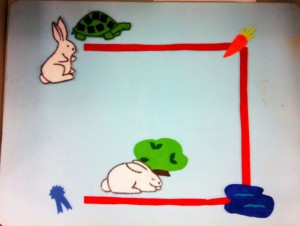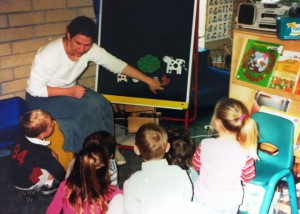Recently Cate asked us some great questions about how we choose to adapt stories to the flannelboard, and I am finally getting a chance to answer one of them!
I have to admit that I don’t think of adapting picture books into flannelboard sets very often, mostly because the only storytime I do these days is a baby storytime, and I think most flannel stories are a little too long for that crowd. When I do have a chance to present toddler and preschool storytimes, I am so excited about the chance to share “big kid” books that I read as many as I can, and choose shorter rhymes and songs for my flannelboard activities.
However, I do have a couple of flannelboard stories in my repertoire, so I’m going to tackle one of Cate’s questions about the “Flannelizing” process. She asked, “What makes something Flannelizable?” Specifically, “Why did I choose these stories?”
When I do consider adapting a story, I ask a few questions. The first couple of questions are, “Do I like this story?” and “Is this story too long for storytime?” Once I decide Yes and No, then I keep going.
Are there not too many characters or objects in the story?
For one thing, I don’t want to have to make too many pieces, since making flannelboards can be labor-intensive. Also, I don’t want to have to keep track of too many pieces as I tell the story (my lap can only handle so many of them before they start abandoning ship and falling to the floor), and I don’t want the kids to have to keep track of too many pieces, either.
I made a Gingerbread Boy set for my daughter’s preschool once. They were reading Jan Brett’s “Gingerbread Baby” at the time, so I made pieces that matched up exactly to that version. This set was intended for the kids to play with after they’d read the story, so they could make up their own Gingerbread Boy story or retell parts or all of the Jan Brett book. There were a LOT of pieces…the boy, the gingerbread baby, the girls at the well, the cat, the fox…
(I am SO SURE I took a photo before I gave the set to the school, but that was 10 years ago and I can’t find it!)
If I were going to tell this story on a flannelboard in storytime, I would adapt it, and use fewer characters…maybe the gingerbread baby, the goat, the cat, and the fox.
Will the story make sense if the felt pieces are fairly static on the board?
For my presentation style, there’s a difference between a flannelboard story and a puppet show. In the puppet show, I use the motion of the puppet to help show an emotion or an action. In a flannelboard, the pieces are smaller, and my style is to keep them on the board–where they’re not hidden by my hand and where everyone can see them. If I’m going to be tempted to move the pieces around in the air to get my point across, then flannel is not the best medium for me to tell that story.
Think about the Three Billy Goats Gruff: I would tell this story with the 3 goats, the bridge, and the troll as my pieces. The bridge would go up first, and then when the first billy goat was going across, I’d just put him on the board on the bridge…I wouldn’t “walk” him across the bridge, or wiggle him when he was talking to the troll. He’d just stay on the bridge while I put the troll up and told their part of the story. Then I’d move the first billy goat from the bridge to the other side, and put the 2nd billy goat on the bridge.
This is just my style! It’s not the right way or the wrong way. But since it is my style, I’m going to be looking for stories that will make sense as a series of static scenes like this.
Are the characters or objects fairly distinct from one another?
Flannel pieces are small, and the level of detail for each piece is usually pretty low. I don’t want kids to have to tell the difference between, say, a donkey and a horse, in order to make sense of the story. So I want to make sure that the pieces are unique, and easily recognizable as whatever they’re supposed to be.
In the Tortoise and the Hare, there’s a pretty clear difference between a white bunny and a green turtle, even without a lot of detail involved. And they’re the only two pieces you really need to tell the story, as well. In this case, I added in red lines for the race course, a carrot, a pool, and a shady bush (to distract the hare), and a blue ribbon; different shapes for all of them.
Can I use the illustrations in the book as a pattern, or am I going to have to design them or search them out myself? If there is a pattern available, do I like it?
This is partly a time issue, and partly a visual issue.
In terms of time, can I just take the book to the photocopier and have my patterns ready to go? Or is it going to take me longer investment of time to search for a ready-made pattern online, or find clipart I can use as patterns for the characters and objects, or design my own patterns.
In terms of visuals, it’s simply that I want to like the flannelboard set I make! If I don’t find the available patterns appealing, or I know it’s beyond my artistic capabilities to design patterns that I will be satisfied with, I’m not going to want to spend the time and effort to make the pieces.
Recently I shared the set I made for The Mouse and the Apple. In this case, I loved the round, clean shapes of the animals, loved Butler’s distintive style, and knew they wouldn’t be too detailed to make out of felt. I just photocopied pages of the book, and used those photocopies as is for my patterns.
So that’s some of the thinking I do before I adapt a story to the flannelboard. I’d love to hear if there’s a question you ask that I haven’t thought of!
*Sorry about the title. I grew up reading the column “Can This Marriage Be Saved?” in my mom’s Ladies’ Home Journals.




.jpg)

Pingback: Flannel Friday Round Robin: Flannelizable, Defined «